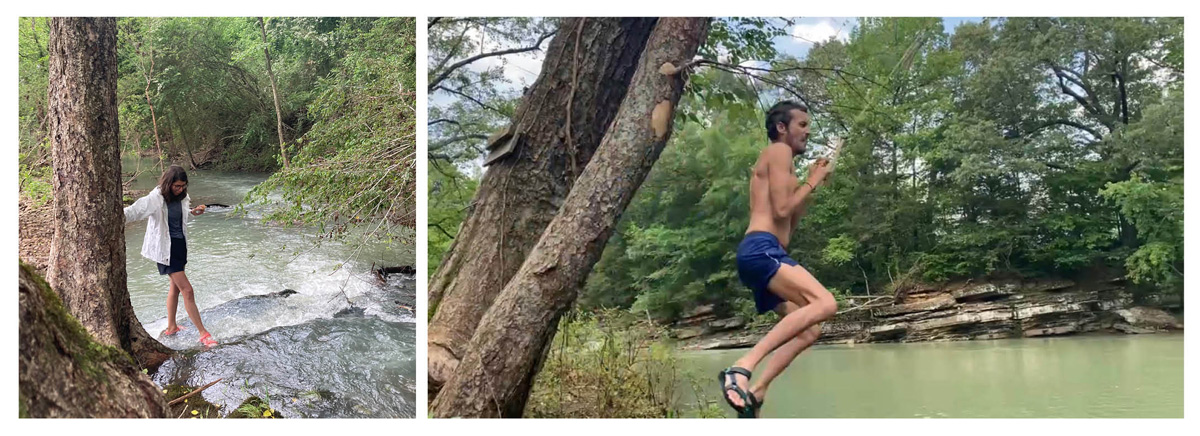Wild and Scenic
Part 2: A River Journey Turns From Wild to Mild
Story and Photography by Brian C. Hurley

The author grins in between frequent bailing on the first leg of the journey.
Just out of earshot of Bluff Hole Park at Mulberry, the river changed abruptly. Any remaining current vanished and the still, murky water perfectly reflected the trees that now grew right along the edge. The sun came out along with the bugs. It seemed a long ways away from the cool rapids and gravel bar we set out from earlier that morning.
As we passed under the remaining half of an old train bridge, we came upon the first boat we’d seen in 20 miles. An old man named Dale in a bass boat paused his fishing to chat about where we’d come from. He gave us directions to the mouth of the river, telling us to stay left and warning that it could get tricky.
Dale was correct. The river widened to a mile, looking more like a lake, and with the lack of a current, we were left to guess what was the main channel and what was a cove. Finally, off in the distance, we could see what appeared to be the mouth of the Mulberry, flowing out into the Arkansas River. Soon, a boat came speeding toward us and eventually we could see that it was just Dale. He had come to check on us and make sure that we’d found the correct path. He also offered us water. We thanked him and headed to the first island in the Arkansas River that had a beach suitable for camping.

Hurley takes time to go for a dip while his wife Ana explores a rapid.
Gear Up for Adventure
Choose your gear wisely when planning your own Arkansas paddling adventure.
BUFFALO CANOE
Year in and year out, Buffalo Canoes are rated among the top craft you can buy. These heirloom boats are built to exacting standards using only the finest components and crafted to last a lifetime. Buffalo Canoes are proudly built here in Arkansas, so you can show your state pride while you float on the state’s tides. buffalocanoemanufacturing.com
SAWYER PADDLE
Propel your excursion with the top-of-the-line Sawyer Voyager Canoe Paddle, as responsive in the water as it is beautiful to look at. Made from laminated Western Red Cedar and Douglas Fir wood, reinforced with fiberglass and trimmed in Dynel ToughEdge, the Voyager delivers incredible feel and control. Also available in a bent shaft model which reduces fatigue in flat water. paddlesandoars.com
ASTRAL LIFE JACKET
Be ready for anything on the water with the Astral E-Ronny life jacket. This comfortable device is cut thinner where it counts to reduce bulk, without sacrificing performance. The design provides a comfortable fit and range of motion for all-day paddling or fishing. Rated an Editor’s Choice by GearLab.com for 2023. astraldesigns.com
The Arkansas River is an entirely different sort of thing than the Mulberry, and is far from meeting any of the National Park Service’s criteria for being wild, scenic or recreational. Like many rivers of its size nowadays, it is, in fact, entirely manufactured — more of an industrial machine than a natural feature.
Through practically all of the state of Arkansas (except for the first few miles at the mouth), the Arkansas River is part of the McClellan-Kerr Navigation System. The most obvious features of this system are the locks and dams that raise and lower boats and turn much of the river into lakes. Less visible, perhaps, are the rocks that line the banks to prevent erosion and the jetties that keep the water flowing through the main channel. That channel is marked by red and green buoys the entire length of the system. Beaches such as the one we camped on at the mouth of the Mulberry only exist because of the way the river has been structured by the U.S. Army Corps of Engineers since the 1970s.
Nevertheless, despite officially being off the Mulberry and on the McClellan-Kerr Navigation System, we were, at that point, more isolated than we’d been before. There were no humans around for miles and certainly not on our quarter-mile long island. We set up the tent, made a small fire, cooked our lentils and sipped whiskey while listening to the fish jump about.
Setting out the following morning, we found canoeing on the Arkansas to be much different than on the Mulberry. Where previously the job mostly involved steering and dumping water from rapids, now it was just relentless paddling. There is little current to speak of, so drifting is not really an option on the Arkansas. Any headwind could send a boat like ours back upstream. It started to rain steadily and the only thing to do was to put our heads down and try to coordinate strokes to be as efficient as possible.
Apart from the occasional eagle or barge spotting, the scenery changed very little. At each bend, and with each drop of rain, we kept hoping to see the next bridge, which would indicate our planned lunch break in Ozark. By the time we saw it, we were thoroughly soaked and getting cold.
While Ozark is one of the few towns directly on the Arkansas River, there is no clear access point. We pulled up on a small sandbar, then walked half a mile on the railroad tracks, climbed through weed-choked ditches and emerged downtown. By that point, we were both shaking with cold. The air conditioning of the one restaurant that was open didn’t help, but the coffee did, a little. The rain continued, so we spent the rest of the afternoon attempting to warm up in the antique mall.
To be continued.


